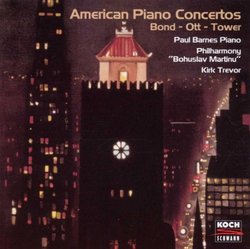| All Artists: Tower, Bond, Ott, Barnes, Trevor Title: Piano Concerto / Black Light / Piano Concerto 2 Members Wishing: 0 Total Copies: 0 Label: Koch Schwann (Germ.) Release Date: 9/21/1999 Genre: Classical Styles: Forms & Genres, Concertos, Instruments, Keyboard, Symphonies Number of Discs: 1 SwapaCD Credits: 1 UPC: 099923133322 |
Search - Tower, Bond, Ott :: Piano Concerto / Black Light / Piano Concerto 2
 | Tower, Bond, Ott Piano Concerto / Black Light / Piano Concerto 2 Genre: Classical
|
Larger Image |
CD Details |
CD ReviewsA Yankee Victory James M. Boubonis | 04/03/2000 (5 out of 5 stars) "This set of excellent recordings of American piano concertos gives the lie to the claim that contemporary music lacks expression of beauty. Paul Barnes gives a flawless performance on three very difficult yet thoroughly listenable modern works. The Bohuslav Martinu orchestra supports admirably.Victoria Bond's "Black Light," a celebration of jazz, while not a jazz piece, is full of jazzy syncopation and frequent use of chords that, though not used as functional jazz harmony, utilize added color tones a la jazz. Numerous other composers have sought to meld jazz with symphonic works: Shostakovich wrote what were really mere caricatures of jazz; Stravinsky's "Ebony Concerto" used the rhythmic phrasing and instrumentation of a big band; Milhaud's "Creation du Monde" used true jazz harmonies of the time; and midwest composer John Downey has used in some pieces what he calls "undercurrent jazz," which I perceive as punctuating the piece with the pulse of jazz music. Bond's piece fits in as an homage to black jazz musicians, using jazzy chords and some jazz rhythms -- though the roots of many of these rhythms could as easily be traced back to Rimsky-Korsakov as to early American jazz musicians. And I'm bothered by the inherent racism of the title -- as if white jazz musicians used some wholly different musical language, or as if white musicians had nothing to do with the development of jazz.After the strident introduction of the first movement, the second movement begins more like the introduction to a Shostakovich symphony than a jazz work, but consists of an intriguing question & answer session between orchestra and soloist. Eventually the two parties overlap and synthesize, and the movement develops into a fascinating alternation of quiet ruminations and contrapuntal dialogue.The third movement is easily the jazziest portion, energetic and heavily percussive.David Ott's piece opens almost immediately with a virtuosic cadenza that Barnes incredibly sails through as though it were kid stuff. Pensive and meandering, and never lacking in musical interest, the movement ends in a thoroughly entertaining cat and mouse chase between Barnes and orchestra, carried off with sparkling brilliance by both cat and mouse.The Adagietto second movement is a brown study, often mysterious and sometimes sombre. The third movement is a jaunty, adventurous scherzo that only an American composer could write. Stay tuned for the intriguing harmonic progressions in the cadenza.Though the form of Joan Tower's concerto is rather episodic, it's full of sonic treats, and Barnes' faultless, expressive play makes it well worth the listen. The second of the two cadenzas contains a surprise, going into a beautiful sequence wholly unexpected given the harmonic language of the rest of the piece. Throughout the recording, Barnes' touch is impeccable. He is not one of the many pianists who sacrifice musicality and soulful expression for brilliance and accuracy; with Paul Barnes you get the whole package."
|

 Track Listings (7) - Disc #1
Track Listings (7) - Disc #1